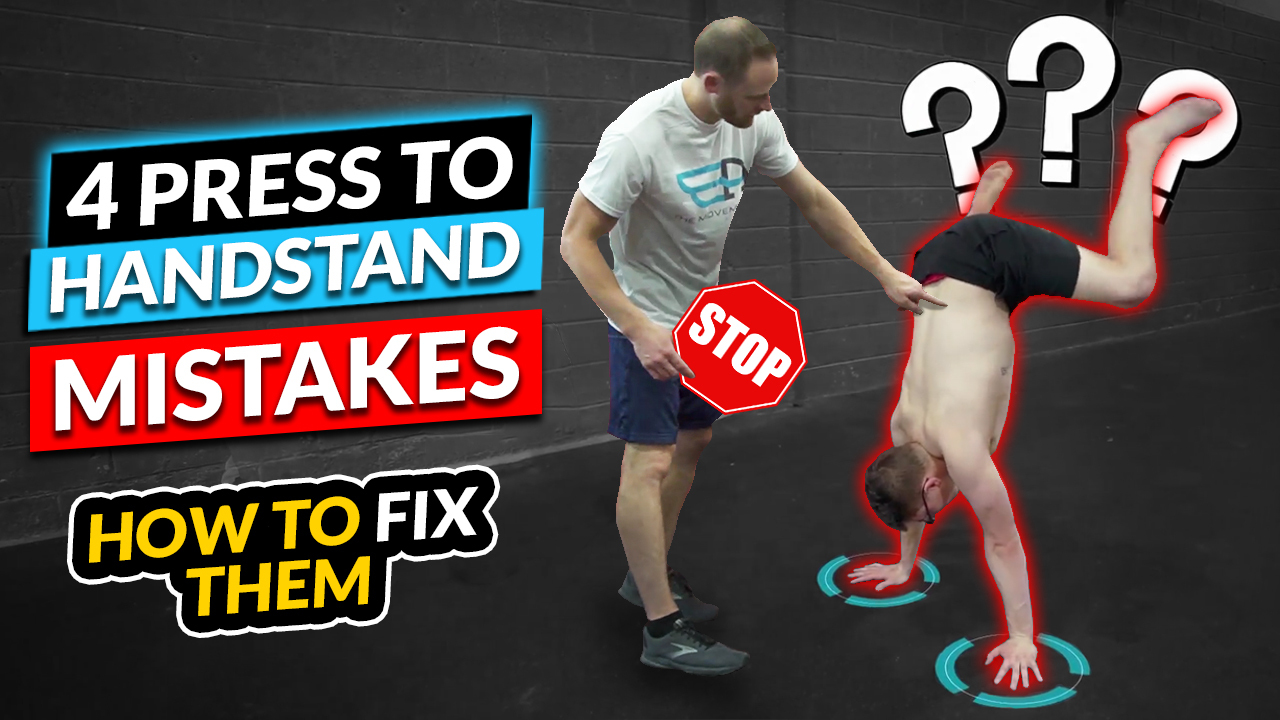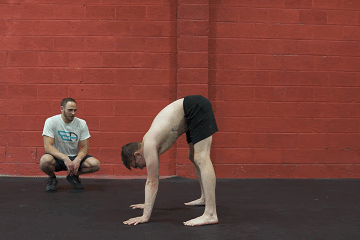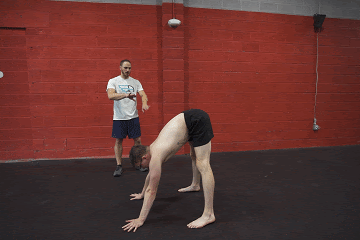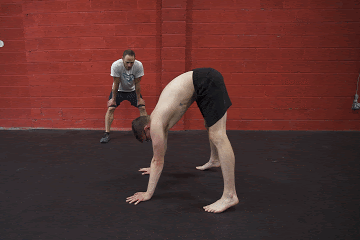Have you ever wondered how people manage to do press to handstands?
Achieving the press to handstand is like mastering a captivating dance of strength and precision.💯
🤸Press to handstand is a challenging and impressive skill in calisthenics and gymnastics. The art of the press to handstand requires not only physical strength but also a deep understanding of your body’s mechanics and balance.
It requires a combination of strength, coordination, flexibility, and balance. Many enthusiasts often struggle with this skill due to common mistakes.
In this article, we’ll discuss the four main areas where these errors occur and how to correct them.😱
🤯What is Press to Handstand?
A press to handstand is an advanced bodyweight exercise that involves transitioning from a seated or lying position on the ground to a fully vertical handstand position.🤸
This means going from a sitting or lying posture to standing on your hands with your body upside down. The entire movement is done without assistance, like a wall or a jump, and without external momentum.
🤜It’s a display of strength, flexibility, balance, and control over one’s body, often performed by gymnasts and calisthenics enthusiasts. Achieving a press to handstand is a significant accomplishment in gymnastics and bodyweight training, requiring physical strength and technique.
Keep reading to find out how to avoid the most typical mistakes with the press to handstand.
The following videos will show you how to perform a press to handstand correctly:
- 📍 Fastest Way to Press to Handstand 11 detailed steps ( PART 1 )
- 📍 Fastest Way to Press to Handstand (PROGRESSIONS PART 2 )
🥺4 Common Press to Handstand Mistakes
Press to handstand mistakes are like detours on the path of progress. They might seem funny in hindsight, but they’re valuable lessons. Embracing these challenges is what makes mastering the press to handstand an intriguing journey.
Now, let’s break down the four common press to handstand mistakes and how to tackle them.
👎Mistake 1: Lack of Coordination
Mastering a successful press to handstand is like a complex muscle dance that needs precise steps. One big problem people encounter when learning this is not being able to coordinate their movements well.
Without the right coordination, the movement becomes disjointed. The legs may wobble and appear unsteady while the core remains inadequately engaged, causing the entire sequence to break down. This lack of coordination can result in a less controlled and often unsuccessful attempt at the press to handstand.
It is crucial to focus on developing your body’s muscle awareness and coordination to address this issue. Here’s how:
- ✊ Muscle Engagement
Train your body to recognize which muscles should be working during the press. This includes the engagement of the shoulders, triceps, core, and the muscles along the back.
- ✊ Leg Pathway
Understand the correct path your legs should follow as they rise toward the handstand position. Typically, you start with your knees tucked and gradually extend them.
- ✊ Leg Straightening
Learn to straighten your legs as you press into the handstand gradually. This controlled leg extension is vital for a graceful and stable transition.
Coordinating all these elements is essential to overcoming the initial hurdle of poor coordination. You’ll develop the muscle memory and awareness required to achieve a smoother, more controlled handstand press with practice.
👎Mistake 2: Lack of Hip Compression
Effective hip compression plays a pivotal role in achieving a successful press to handstand. Hip compression refers to the ability to fold your body at the waist, drawing your upper legs close to your torso.
This position reduces the distance between your hips and your torso, shifting your body’s weight toward your hands, an essential component for maintaining balance and control during the press.
Inadequate hip compression is a common stumbling block for many aspiring handstand practitioners. It often stems from two primary issues:
- ✊ Hamstring Flexibility
If your hamstrings are not flexible enough, pulling your legs close to your torso can be challenging as you progress into the handstand position. Stiff hamstrings limit your ability to tuck your knees and bring your legs toward your chest.
- ✊ Hip Flexor Strength
Conversely, the strength of your hip flexor muscles is also critical for effective hip compression. These muscles play a role in lifting your legs and drawing them toward your torso during the press.
To address this mistake and enhance your hip compression, consider the following strategies:
- ✅ Stretching and Flexibility
Incorporate hamstring stretches and flexibility exercises into your training routine to increase your range of motion and allow for a more efficient tucking of your legs.
Strengthen your hamstrings with these exercises: 📍 17 Best Bodyweight Hamstring Exercises
- ✅ Hip Flexor Exercises
Implement hip flexor strengthening exercises to improve the power needed to lift your legs and facilitate the compression of your hips.
Addressing these elements of hip compression is crucial to perfecting the press to handstand. It’s a fundamental aspect of the movement that significantly contributes to a smoother and more controlled transition into the handstand position.
👎Mistake 3: Not Leaning Forward Enough
A common misstep in the journey to master the press to handstand is failing to lean forward sufficiently into the hands during the execution of the movement. This mistake often stems from shoulder weakness, a crucial element in achieving balance and control.
When the shoulders lack the necessary strength to support a forward lean, it can lead to an imbalance and instability during the press. In this scenario, the weight distribution is not optimal for a successful handstand position, making the entire maneuver more challenging.
To rectify this mistake and improve your press to handstand technique, consider the following steps:
- 🎯 Shoulder Strengthening: Dedicate time to strengthening your shoulder muscles, including the deltoids, trapezius, and serratus anterior. These muscles are essential for providing stability and support for the forward lean.
Strengthen your shoulder by doing the 📍 Best exercises for bulletproof rotator cuffs – Better shoulder performance and reduced risk of injury
- 🎯 Gradual Progression: During your training, incrementally work on leaning forward while maintaining balance. Start with small forward shifts, gradually increasing the degree of lean as your shoulder girdle becomes more robust and capable of bearing the weight.
Addressing this mistake and focusing on shoulder strength and gradual progression will help you achieve the forward lean needed for a press to handstand. This will improve stability, control, and proficiency in this challenging gymnastic skill.
👎 Mistake 4: Opening the Hips Too Early
A frequently encountered error during the press to handstand is the premature opening of the hips. This mistake can be attributed to a combination of factors, including a lack of hip compression and coordination.
When the hips open too soon, it can significantly disrupt the balance and flow of the movement, making it challenging to execute the press successfully.
To overcome this issue and achieve better hip control during the press to handstand, you should consider the following strategies: 👇👇
- ✅ Strong Hip Compression: As mentioned earlier, developing strong hip compression is crucial. This skill allows you to tuck your knees close to your chest, which is essential before opening the hips.
- ✅ Improved Coordination: Focus on honing your overall coordination. Develop a keen sense of timing and control to know precisely when to start opening your hips.
- ✅ Practice and Patience: Correcting this mistake requires practice and patience. Work on your press to handstand drills to enhance muscle memory and awareness of the proper hip movement.
- ✅ Mindfulness: Pay close attention to your body position and the timing of the hip movement during your practice. Mindfulness can be a powerful tool for fine-tuning your technique.
By addressing the premature opening of the hips and developing proper hip compression and coordination, you’ll be better equipped to execute the press to handstand with smoother, more controlled movements and improved balance.
Here’s a related video discussing common mistakes to press to handstand:
Video link: 📍 Avoid These 4 Press to Handstand Mistakes! And Learn How to Fix Them
🧐 Frequently Asked Questions
🔎 How can I stay motivated while overcoming these common mistakes in the press to handstand?
Staying motivated can be tough, but every mistake is a step toward improvement. Set small goals, track your progress, and enjoy the learning process. Celebrate small wins to keep the motivation alive.
🔎 Are there any safety tips to consider while working on the press to handstand and avoid mistakes?
Safety is paramount. Ensure you practice on a soft, non-slip surface and have a spotter. If you’re just starting, consider using props like yoga blocks to assist you until you build confidence and strength.
🔎 Can age and body type affect the ability to perform the press to handstand?
Age and body type can influence your progress, but they shouldn’t be considered limitations. Younger individuals might have an advantage in flexibility, but people of all ages and body types can learn the press to handstand with dedication and proper training.
🔎 How can I prevent injury while working on the press to handstand and trying to correct these mistakes?
Injury prevention is essential. Warm up before practice, gradually increase the intensity of your training, and avoid pushing your limits too quickly. If you experience pain or discomfort, listen to your body and rest as needed.
🔎 What’s the role of breath control in achieving the press to handstand, and how can improper breathing lead to mistakes?
Breath control is essential for maintaining stability and balance. Improper breathing can disrupt your rhythm and concentration, which may lead to coordination errors. Focus on steady, rhythmic breathing to enhance your practice.
💥Conclusion
Press to handstand is a remarkable skill that combines strength, balance, flexibility, and coordination.💯
👊It’s normal to face various challenges when trying to master it. Identifying and correcting common mistakes, such as a lack of coordination, hip compression issues, insufficient forward-leaning, and premature hip opening, is essential for progress.
By understanding these common errors and working on their corrections, you can achieve your goal of performing a perfect press to handstand. Stay consistent, practice diligently, and you’ll be well on your way to mastering this impressive calisthenics skill.🤸
💥If you’re eager to embark on your calisthenics journey, seizing the opportunity to begin with a solid foundation can make all the difference. Take a step toward your fitness goals by taking a Free Assessment with The Movement Athlete.
Its free assessment is your starting point for a personalized fitness journey. It can create a customized training plan that combines strength, mobility, and skill development exercises to optimize your progress.💪🔥









